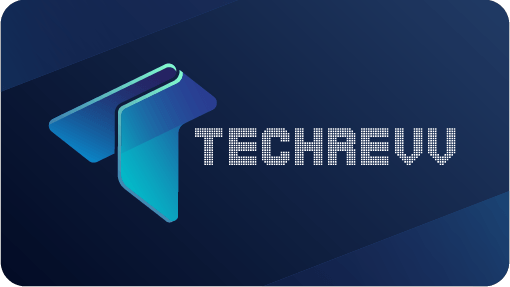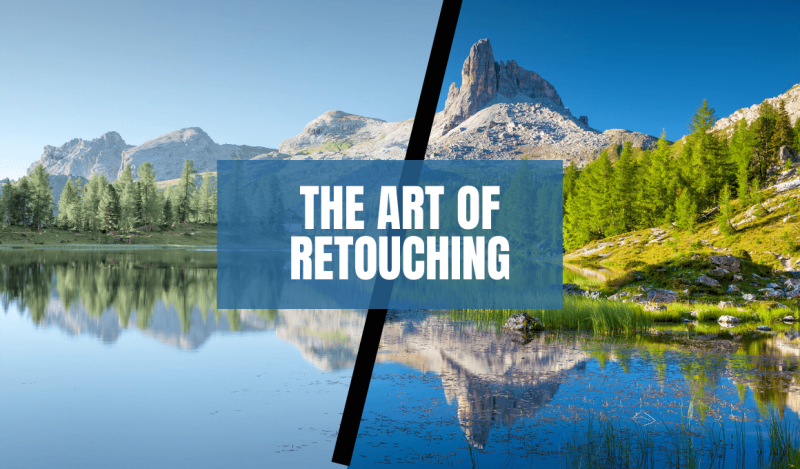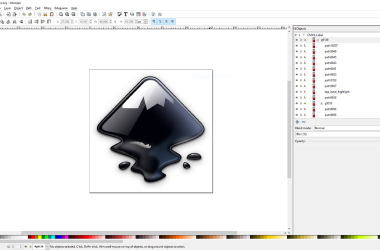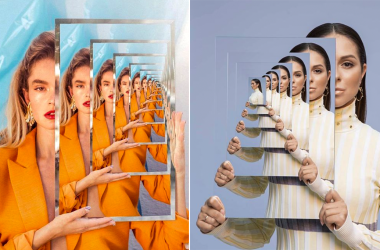In the vast canvas of visual storytelling, where pixels meet imagination, the art of retouching in graphic design is a dance of creativity and precision. It's not merely about erasing imperfections or enhancing features; it's about crafting a visual symphony that captivates and communicates. Let's explore this intricate art form and uncover the magic that unfolds within the realm of graphic design retouching.
Brushstrokes of Perfection:
At the heart of retouching lies the desire to reveal the true essence of a design, much like an artist carefully brings out the beauty hidden within a canvas. In graphic design, retouching is a delicate process where every brushstroke has a purpose. It's about refining details, balancing contrasts, and transforming a composition into a masterpiece.
The Canvas Speaks:
Imagine a photograph as a canvas waiting to narrate a story. Armed with their digital brushes, graphic designers dive into the narrative, accentuating the highs and lows, much like a novelist crafting a compelling plot. Every stroke adds depth, texture, and emotion, transforming a static image into a living, breathing piece of art.
Harmonizing Colors and Tones:
Graphic design retouching is akin to orchestrating a symphony of colors. It involves not just correcting imbalances but infusing life into the palette. A subtle shift in tones, a play of highlights and shadows – these nuances create an atmosphere, setting the mood for the viewer. It's the art of making colors resonate with the intended emotion.
Beyond Flawless Faces:
While retouching often conjures images of flawless faces, it extends far beyond skin-deep beauty. It's about fine-tuning every element within a design – from the meticulous details of a product in an advertisement to the organic textures in a nature-inspired layout. Graphic design retouching is about amplifying the visual impact, making every pixel count.
Crafting a Visual Identity:
In the world of branding and marketing, graphic design retouching plays a pivotal role in shaping visual identities. It ensures that every image aligns with the brand's personality, creating a consistent and memorable visual language. It's not just about making things look good; it's about making them uniquely and unmistakably yours.
The Dance of Light and Shadow:
Light is the storyteller in retouching. It's about understanding the dance of light and shadow, how they play on surfaces, revealing depth and dimension. Graphic designers wield their virtual brushes to sculpt light, creating a narrative that transcends the two-dimensional constraints of a screen.
Preserving Authenticity:
While retouching is an art of enhancement, it's equally a practice of preserving authenticity. Graphic designers tread carefully, ensuring that every modification aligns with the intended narrative without distorting reality. The goal is not to erase imperfections but to celebrate the uniqueness that lies within them.
The Journey of Mastery:
Mastery in the art of retouching is a journey, not a destination. It's a continuous exploration of techniques, an experimentation with styles, and a commitment to evolving alongside the ever-changing landscape of graphic design. Each project becomes a canvas for growth, pushing the boundaries of creativity.
The art of retouching in graphic design is a manifestation of the designer's vision and storytelling prowess. It's not just about refining images; it's about breathing life into pixels, making them resonate with the intended narrative. As graphic designers, let's embrace the magic of retouching, turning each project into a visual masterpiece that leaves an indelible mark on the canvas of creativity.
Why Is Retouching Important In Graphics?
Retouching is important in various fields, especially in photography and visual media. Here are several reasons why retouching holds significance:
Enhancement of Beauty and Aesthetics:
Retouching allows for enhancing a subject's features, bringing out their natural beauty. It helps create visually appealing images by refining details and improving overall aesthetics.
Professionalism in Photography:
In professional photography, retouching is often necessary to meet clients' high standards and industry expectations. It ensures that images are polished, flawless, and meet the desired level of quality.
Correction of Imperfections:
Retouching allows for correcting imperfections such as blemishes, scars, wrinkles, or other skin flaws. This is particularly important in portrait photography, where the goal is often to present the subject in the best possible light.
Consistency and Branding:
In commercial and branding contexts, retouching helps maintain consistency in the visual representation of a brand. It ensures that images align with the brand's aesthetic and messaging, contributing to a cohesive and professional image.
Highlighting Details:
Retouching enables photographers to emphasize important details in an image. This can include enhancing highlights in the eyes, adding sharpness to certain features, or emphasizing textures.
Creative Expression:
Retouching allows for creative expression and experimentation. Photographers can use various techniques to create unique and artistic effects, adding a personal touch to their work.
Corrections in Lighting and Color:
Photographs may be affected by variations in lighting conditions or color imbalances. Retouching provides the means to correct these issues, ensuring that the final image accurately represents the intended mood and atmosphere.
Product Presentation:
In product photography, retouching is crucial for presenting items in the best possible way. This includes cleaning up any imperfections on the product, adjusting colors, and ensuring that the product stands out.
Storytelling and Emotion:
Retouching can enhance an image's emotional impact, emphasizing certain expressions, moods, or narrative elements. This contributes to effective storytelling through visual media.
Meeting Client Expectations:
Clients often have specific expectations regarding the final look of their images. Retouching allows photographers to meet these expectations and deliver a product that aligns with the client's vision.
While retouching is a valuable tool, using it responsibly and maintaining a balance is essential. Overly excessive retouching can lead to unrealistic and unnatural results, so it's important to approach the process with care and consideration for the context and purpose of the images.
Platforms To Go For Retouching
Regarding retouching, several powerful platforms and software tools are available, catering to various needs and skill levels. Here are some widely used platforms for retouching:
Adobe Photoshop:
- Description: Adobe Photoshop is the industry standard for image editing and retouching. It offers a comprehensive set of tools for everything from basic retouching to advanced photo manipulation.
- Key Features: Healing Brush, Clone Stamp, Dodge and Burn tools, Layer Masks, Filters.
Adobe Lightroom:
- Description: Lightroom is an excellent choice for photographers and beginners. It provides non-destructive editing tools and a user-friendly interface.
- Key Features: Basic adjustments, Color correction, Presets, Graduated and Radial filters.
Capture One:
- Description: Capture One is popular among professional photographers for its robust color grading and tethering capabilities. It's especially known for its excellent handling of raw files.
- Key Features: Color Editor, Layers, High Dynamic Range (HDR) tools.
Affinity Photo:
- Description: Affinity Photo is an affordable and powerful alternative to Adobe Photoshop. It offers a wide range of features for retouching and photo editing.
- Key Features: Advanced selection tools, Frequency Separation, HDR merge.
GIMP (GNU Image Manipulation Program):
- Description: GIMP is a free, open-source alternative to Photoshop. It provides a wide array of tools for retouching, making it accessible to users with different budgets.
- Key Features: Layers, Masks, Filters, Extensive plugin support.
DxO PhotoLab:
- Description: DxO PhotoLab is known for its advanced automatic corrections based on artificial intelligence. It's a good choice for photographers looking for efficient and quick retouching solutions.
- Key Features: ClearView Plus, DeepPRIME noise reduction, Smart Lighting.
Skylum Luminar:
- Description: Luminar is a user-friendly photo editing software with AI-powered quick retouching tools. It's suitable for both beginners and advanced users.
- Key Features: AI-enhanced tools, Filters, Presets.
Pixlr:
- Description: Pixlr is an online photo editing platform with a user-friendly interface. It's suitable for quick edits and basic retouching tasks.
- Key Features: Layers, Filters, Adjustment tools.
Snapseed:
- Description: Snapseed is a mobile app developed by Google that offers a range of powerful tools for photo editing and retouching on the go.
- Key Features: Selective editing, Filters, Brush tools.
Paint.NET:
- Description: Paint.NET is a free, Windows-based image editing software with a straightforward interface. While less advanced than some professional tools, it's great for basic retouching.
- Key Features: Layers, Filters, Plugins support.
Choose the platform that aligns with your skill level, budget, and specific retouching needs. Many of these tools offer trial versions, allowing you to explore their features before deciding.
Tools To Go For Retouching
Retouching involves a variety of tools to enhance and perfect images. The choice of tools depends on the retouching needs and the software being used. Here are some of the most common retouching tools:
Healing Brush:
- Purpose: Used for repairing imperfections in an image by sampling pixels from one area and blending them with another.
- Applications: Removing blemishes, scars, and unwanted elements.
Clone Stamp:
- Purpose: Similar to the Healing Brush, it duplicates pixels from one part of an image and replicates them elsewhere.
- Applications: Cloning objects, removing distractions, and duplicating textures.
Dodge and Burn Tools:
- Purpose: Dodge lightens areas of an image, while Burn darkens them. These tools add depth and enhance details.
- Applications: Enhancing highlights and shadows, sculpting facial features.
Patch Tool:
- Purpose: Allows users to select and replace a part of an image with pixels from another area.
- Applications: Repairing larger areas or objects, such as removing wrinkles.
Brush Tool:
- Purpose: A versatile tool for painting and applying adjustments.
- Applications: Adding or reducing exposure, applying color corrections, and more.
Smudge Tool:
- Purpose: Smudges or blends pixels together, creating a smoother transition between colors or textures.
- Applications: Softening transitions, blending edges.
Gradient Tool:
- Purpose: Applies a gradual blend between two or more colors.
- Applications: Creating smooth transitions in backgrounds or adjusting lighting effects.
Liquify Tool:
- Purpose: Distorts and reshapes pixels, allowing for alterations to objects' overall shape and structure.
- Applications: Slimming figures, adjusting facial features.
Sharpening Filters:
- Purpose: Increases the contrast between pixels, enhancing details.
- Applications: Sharpening specific areas like eyes, hair, or textures.
Blur Tool:
- Purpose: Softens or blurs pixels in an image.
- Applications: Creating a bokeh effect, smoothing skin.
Color Correction Tools:
- Purpose: Adjusts color balance, saturation, and hue.
- Applications: Correcting skin tones, enhancing or desaturating colors.
Frequency Separation:
- Purpose: Splits an image into two layers – one for texture and the other for color – allowing for separate adjustments.
- Applications: Fine-tuning skin texture while preserving color and tone.
Pen Tool:
- Purpose: Creates precise selections or paths.
- Applications: Cutting out objects and creating masks for detailed adjustments.
Layer Masks:
- Purpose: Allows non-destructive editing by revealing or hiding parts of a layer.
- Applications: Blending multiple adjustments seamlessly.
When used skillfully, these tools empower retouchers to transform ordinary images into visually stunning works of art. The key is understanding each tool's purpose and application and combining them to achieve the desired results.
Difference between retouching and editing
While “retouching” and “editing” are often used interchangeably, they can have distinct meanings depending on the context, especially in photography and image processing. Here's a general breakdown of the differences between retouching and editing:
Retouching:
Definition:
Retouching is a subset of the broader editing process. It specifically refers to the act of making small, selective adjustments to an image to improve its appearance.
Purpose:
Enhancement: Retouching is primarily aimed at enhancing specific aspects of an image, such as refining details, correcting imperfections, or emphasizing certain features.
Techniques:
Selective Adjustments: Retouching involves targeted adjustments, often using tools like the clone stamp, healing brush, or dodge and burn, to address specific areas of the image.
Applications:
Portrait Retouching: Commonly used in portrait photography to improve skin texture, remove blemishes, and enhance facial features.
Examples:
- Removing Blemishes: Retouching might involve removing acne, scars, or other imperfections from a subject's face.
- Softening Skin: Applying techniques to create smoother and more even skin tones.
Editing:
Definition:
Editing is a broader term encompassing various actions to modify, enhance, or manipulate an image. It includes retouching but extends beyond it.
Purpose:
Overall Modification: Editing involves a more comprehensive approach to image manipulation, covering adjustments to exposure, color, composition, and more.
Techniques:
Global Adjustments: Editing includes global adjustments that affect the entire image, such as exposure, contrast, saturation, and color balance.
Applications:
Color Correction: Editing may involve correcting color imbalances or enhancing the overall color scheme of an image.
Cropping and Composition: Adjusting the composition by cropping falls under the umbrella of editing.
Examples:
- Adjusting Exposure: Editing might involve brightening or darkening an entire image to achieve the desired exposure.
- Changing Color Tones: Editing can include shifting the overall color tones to create a specific mood.
In Summary:
Retouching is a subset of editing. It involves targeted adjustments to refine specific areas of an image, often for aesthetic purposes.
Editing is a more comprehensive term. It encompasses a wide range of actions, including retouching, to modify and enhance an image's overall quality and appearance.
In practice, the terms are sometimes used interchangeably, and the distinction can vary depending on the industry and individual preferences. Understanding the specific context in which these terms are used can help clarify their meanings.
Conclusion
In the realm of visual artistry, retouching tools serve as brushes on a canvas, allowing creators to weave narratives and unveil the inherent beauty within each image. From the meticulous precision of the Healing Brush to the versatile strokes of the Brush Tool, retouching tools empower artists to enhance, refine, and transcend the ordinary.
As we conclude this exploration into the retouching world, it becomes evident that these tools are more than mere pixels on a screen; they are instruments of transformation. The art of retouching is a dance of creativity and technique, a delicate balance between perfection and authenticity. It's about sculpting light, harmonizing colors, and telling visually resonating stories.
Whether in the hands of a seasoned professional or an aspiring enthusiast, these tools become conduits for expression, allowing individuals to shape reality with every click and stroke. As technology advances, so does the palette of possibilities for retouching, offering artists new avenues for exploration and innovation.
In the tapestry of visual storytelling, retouching tools are the artisans' instruments, capable of turning the mundane into the extraordinary. The journey of mastering these tools is a continuous evolution, a commitment to honing skills and finding one's unique voice within the ever-expanding landscape of creative expression.
So, as we step away from this exploration into the art of retouching, let us carry with us the understanding that each tool is a conduit for imagination and each image an opportunity to breathe life into pixels. May these retouching tools continue to be wielded with purpose, weaving stories that captivate, inspire, and transcend the boundaries of the visual realm.










I was extremely pleased to discover this site. I wanted to thank you for your time just for this wonderful read!! I definitely enjoyed every bit of it and i also have you saved as a favorite to look at new stuff on your blog.
Thank You for your feedback!